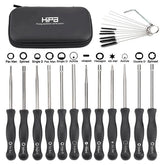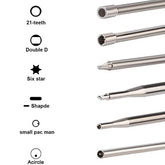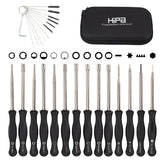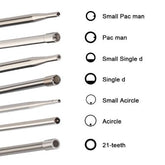Is Your Leaf Blower Losing Its Breath? How to Fix a Leaf Blower That Won't Rev Up
There’s nothing more frustrating than firing up your leaf blower for a big yard cleanup, only to find it sputters and wheezes instead of roaring to life. A leaf blower that won’t rev up is a common problem, but the good news is that it’s often caused by a few simple issues you can fix yourself.
Before you call a repair shop or consider buying a new machine, let’s walk through the most common culprits—especially a clogged spark arrestor and carburetor problems—and how you can get your blower back to full power.
First, The Simple Stuff: The Quick Checks
Always start with the easiest solutions first. Often, the problem is simpler than you think.
Fresh Fuel: Old, stale gasoline is the #1 enemy of small engines. If your fuel is more than a month old, drain it completely and fill up with fresh, high-octane gasoline mixed with the correct 2-cycle oil ratio (check your manual!).

Air Filter: A dirty air filter chokes the engine, preventing it from getting the air it needs to combust properly. Remove the filter and tap it clean or wash it (if it's foam). If it's filthy, replace it.

Fuel Line & Filter: Check the fuel line for cracks and ensure the in-tank fuel filter (if equipped) isn’t clogged.
If you’ve checked all these and your blower is still sluggish, it’s time to look at the two most common mechanical issues.
Culprit #1: The Clogged Spark Arrestor
What it is: The spark arrestor is a small screen located on the muffler. Its job is to prevent hot sparks from exiting the exhaust, which is a crucial safety feature. However, over time, it can become caked with carbon deposits and soot.

Why it causes problems: When the spark arrestor is clogged, exhaust gases can’t escape efficiently. It’s like trying to breathe out with a hand over your mouth. The engine can't clear its lungs, leading to a significant loss of power and an inability to rev up.
How to Fix It:
Locate it: Find the muffler (usually a metal box on the side of the engine). The spark arrestor is a small plate with a screen, held on by a single screw.
Remove it: Once the engine is completely cool, remove the screw and carefully take out the spark arrestor screen.
Clean it: Use a wire brush to scrub away the carbon buildup. For stubborn grime, you can briefly use a propane torch to burn it off (hold it with pliers!) or soak it in solvent.
Reinstall: Once it’s clean and dry, reinstall it. Do not run the blower without it, as it is a critical safety component.
This simple 5-minute fix often restores power instantly!
Culprit #2: Carburetor Issues
What it is: The carburetor is the heart of your leaf blower’s engine. It’s a delicate component that mixes air and fuel in a perfect ratio for combustion. Two main things go wrong: clogs and diaphragm issues.
Why it causes problems:
Clogs: Old fuel leaves behind sticky varnish and gums that clog the carburetor's tiny jets and passages. This starves the engine of fuel, causing it to run lean, stall, and refuse to accelerate.
Dirty Air Filter: A dirty air filter is often the root cause of carburetor issues! It allows unfiltered air to pass through, leading to clogs and wear.
Diaphragm: The carburetor has flexible diaphragms that pump fuel. Over time, these can become stiff or cracked, preventing fuel from moving through the system.

Image Credit-Youtube Channel Donyboy73
Carb Cleaner: Often, you can clean the carb without removing it. Locate the carburetor and spray a generous amount of carburetor cleaner into the air intake while the engine is running. This can help dissolve minor clogs. (Always follow the cleaner's safety instructions).
Deep Clean (Rebuild): For more stubborn issues, you’ll need to remove the carburetor, disassemble it, and soak it in a specialized carburetor cleaner. This involves carefully cleaning all the jets and passages with a fine wire.
Replacement: Sometimes, especially if the diaphragms are hardened or the body is damaged, the most cost-effective and reliable solution is to simply replace the entire carburetor. Cheap and reliable replacement carbs are widely available online for most models and are often easier to install than rebuilding an old one.
Other Potential Causes
If the issues above don’t solve the problem, consider these less common culprits:
Ignition Coil: A weak spark can cause power loss.
Fuel Cap Vent: A clogged vent in the gas cap creates a vacuum in the tank, preventing fuel from flowing to the carburetor. Try running the blower with the gas cap slightly loose to test this.
Compression: Worn piston rings or a scored cylinder can cause low compression, leading to a lack of power. This is a more serious repair.

Know When to Call a Pro
If you’ve gone through all these steps and your leaf blower is still not performing, it might be time to take it to a small engine repair shop. They can diagnose deeper issues like engine seals or internal wear.
With a little patience and these tips, you can likely solve the problem yourself, save some money, and get back to conquering those leaves in no time!
Happy Blowing!
Disclaimer:
Always prioritize safety. Disconnect the spark plug wire before performing any maintenance to prevent accidental starting. Refer to your owner’s manual for model-specific instructions.























